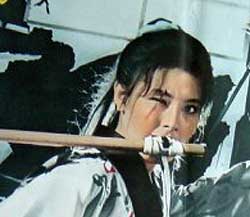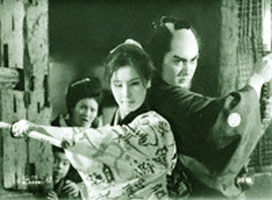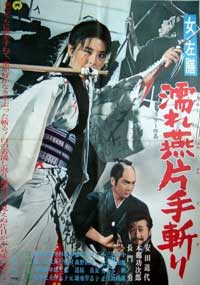JAPANESE SWORDSWOMEN III:
One-Armed Swordswoman
 In The Lefty Fencer (Onna Sazen: Nuretsubame katate giri, 1968), Michiyo Yasuda plays the one-eyed one-armed swordswoman. In The Lefty Fencer (Onna Sazen: Nuretsubame katate giri, 1968), Michiyo Yasuda plays the one-eyed one-armed swordswoman.
She is offered the chance to settle down with a beautiful samurai. He is willing to give up his swords if she will give up hers, & they could live as farmers. Her reply? "My only friend is my sword." And off into the sunset she goes.
This is a great sequence on so many levels. The swordswoman is not all that uncommon in Japanese cinema, & she frequently whines about never having had a chance for "women's happiness," & is just so totally bummed out to have to have adventures instead of being a housewife. Never so the lefty swordswoman!
So too such tales tend to assume the man of a pairing will continue to live his life, but here a the adoring man is willing to change his life if she will change hers. Much more fair than the typical way the story is told. But still, for the Left Fencer, just no way she's going to bore herself with so-called woman's happiness, no matter the terms.
The Lefty Fencer is also known as the Female Sazen, after Tange Sazen, the male one-eyed one-armed hero of many, many films from the silent era onward.
 The earlier installment in this two-film series was called The One-Eyed One-Armed Swordswoman (Onna Sazen. 1968) & gave the origin of the character. The earlier installment in this two-film series was called The One-Eyed One-Armed Swordswoman (Onna Sazen. 1968) & gave the origin of the character.
She was the survivor of a massacre by an evil lord who wanted to obtain a rare sword in the samurai family's possession.
The little girl, left for dead, survives in spite of the loss of an eye & an arm. She's raised & trained by an aging retainer in order to pursue kataki-uchi, vengeance, when she is grown. This sort of theme generally overshadows the minor asides about swordswomen wanting "women's happiness."
One-Eyed One-Armed Swordswoman & The Lefty Fencer taken together tell the whole story. Neither of these films quite stands on its own, but are quite impressive as a single entity. No doubt a longer series of films was intended but box-office was insufficient to make further installments, but these two are complete in themselves.
The portrayal of the female Tange Sazen is a curious mixture of believability & unlikelihood. Since the "bakemono-onna" or monster-woman is clearly very beautiful despite her scarred eye & missing arm, it is understandable that a samurai would be impressed & fall in love with her.
All the same, the director felt it necessary to feminize the character by having her clad in late-Tokugawa period restrictive clothing, reminiscent of The Crimson Bat films. These costumes made her fight scenes occasionally unbelievable.
On the other hand, she speaks mostly in the masculine forms of Japan's dichotomized language, sounding more like a gruff samurai from a kabuki play than a sweet girl. It's unclear what the director thought the character should be, if even the director knew. But one thing's certain: Michiyo Yasuda ought to have become more famous & her films more easily accessible!
Director Kimiyoshi Yasuda wasn't the first to tell the story of a female version of Tange Sazen, & to a degree the Lefty Fencer film pair is a remake of Nobuo Nakayama's Onna Sazen: Yoko no maki (Female Sazen: Story of Bewitching Fire, 1937) & Onna Sazen: Masho ken no maki (Female Sazen: Story of a Devilish Sword, 1937), starring Komako Hara as the lefty fencer.
These alas I've never had an opportunity to see, & am uncertain if they even survive. The character was reprised in Taizo Fuyushima's Onna Sazen: Tsubanari muto ryu no maki (1950).
copyright © by Paghat the Ratgirl
|


